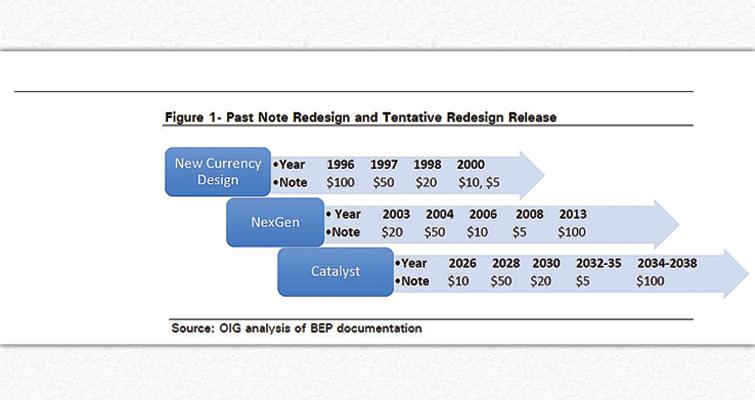OIG report on BEP includes update on redesign schedule Community Comments
The June 2020 Office of Inspector General Report on the Bureau of Engraving and Printing’s progress on implementing new note designs contains some useful information about the future of United States paper money. The report will likely disappoint some Harriet Tubman $20 proponents, and parts of it amount to a pointed criticism of decision making outside of established protocols.
In the last 90 years, since the introduction of the current small-size notes, United States currency has undergone two major redesigns. The first, from 1996 to 2000 was simply called “New Currency Design,” with the $100 denomination in 1996, the $50 note in 1997, the $20 note in 1998, and the $10 and $5 denominations in 2000.
The second redesign began not longer after the first ended. It was called “NexGen” and saw a new $20 note debut in 2003, followed buy the $50 note in 2004, the $10 denomination in 2006, the $5 note in 2008, and the $100 note in 2013.
The next redesign will begin production in 2026, and it has both a name, “Catalyst,” and a tentative production schedule: the $10 note in 2026, the $50 note in 2028, $20 note in 2030, $5 note sometime from 2032 to 2035, and the $100 note sometime from 2034 to 2038.
These dates are when the notes are estimated to be ready for production, not the release dates to the public.
Since 2013, the $10 note has always been the first note in the redesign sequence, and there was only one change to the order. “In 2018,” the report says, “based upon a security threat assessment, the sequence was changed and the $5 note and the $50 note sequence were switched.”
The BEP has confirmed to Coin World that changes have not been recommended to the cotton/linen substrate used for the $10 or the $50, despite a report published at a website that covers new bank note releases worldwide.

Learning from the past
The Catalyst series is the first to be developed under a new process that owes much to the problems and lessons learned in developing the NexGen $100 note. Procedures include a Banknote Development Process from 2012 and a Technology Development Process begun in 2013. The first, still evolving, is notable for how it integrates new security features into the currency design as well as how it develops design concepts. The latter is used to develop technologies that can be included in what BEP makes.
Central to the new system is the work of the Advanced Counterfeit Deterrence Steering Committee. The Committee’s policy, as illustrated by Catalyst, is to redesign the denominations collectively, as part of a family. Each note will have similar architecture, but may have different security features, based on the counterfeiting threat for each denomination. The full design of a note in a new family cannot be finalized immediately because placement of security features can radically affect a design. That is why design is not revealed until six months before a note will issue, allowing only enough time for public education about new security features. A note family is defined as the $5, $10, $20, $50, and $100 notes.
The $1 and $2 notes have not been redesigned because they are not serious targets of counterfeiters. Also, redesign of the $1 note is prohibited by law.
Tubman redesign
Under the heading “Other Matter,” the OIG received congressional interest for an investigation into the circumstances surrounding the redesign of the $20 (Tubman) note. The investigation found that in April 2016, an announcement about the proposed reveal of note design concepts in 2020 “was made outside the formal note development governance structure, and without the recommendation of the ACD.” It added that “the sequence schedule for note redesign has remained the same since 2016 and the ACD never intended the release of the Catalyst series design in 2020,” as Treasury Secretary Jacob Lew suggested could occur.
As of the June 2020 date of the report, the $20 note had not yet even entered the Banknote Development Process, where its design concept will be eventually finalized.
Connect with Coin World: Sign up for our free eNewsletterAccess our Dealer Directory Like us on Facebook Follow us on Twitter

